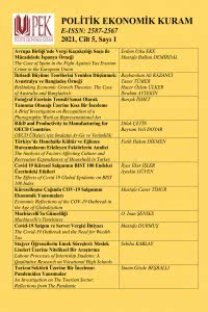Hoşnutsuzluk Endeksi ve Takipteki Kredi Oranları İlişkisi: Türkiye Ekonomisi Üzerine Ampirik Bir Analiz
Hoşnutsuzluk Endeksi, Sefalet Endeksi, Takipteki Krediler
The Relationship Between the Economic Discomfort Index and Non Performing Loan Ratios : An Empirical Analysis for Turkish Economy
Hoşnutsuzluk Endeksi, Sefalet Endeksi, Takipteki Krediler,
___
- Ahmad, M. I., Guohui, W., Hasan, M., Ali, R., Rafiq, M. Y., & Rehman, R. (2016). Non-performing loans and economic growth. Journal of Economics, Business and Management, 3, 584-586.
- Barro, R. J. (1999). Reagan vs. Clinton: Who’s the economic champ. Business Week, 22(5). Erişim: https://scholar.harvard.edu/barro/files/99_0222_reaganclinton_bw.pdf
- BDDK (2016) Kredilerin Sınıflandırılması ve Bunlar İçin Ayrılacak Karşılıklara İlişkin Usul ve Esaslar Hakkında Yönetmelik. Erişim: www.bddk.org.tr
- CATO,2021, Erişim: https://www.cato.org/commentary/hankes-2020-misery-index-whos-miserable-whos-happy
- Cohen, I. K., Ferretti, F., & McIntosh, B. (2014). Decomposing the misery index: A dynamic approach. Cogent Economics & Finance, 2(1), 991089.
- Data Turkey. Erişim: https://dataturkey.com.tr
- Ewa, L. (2009). Okuns and Barros Misery Index as an alternative poverty assessment tool. Recent estimations for European countries.
- Lovell, M. C., & Tien, P. L. (2000). Economic discomfort and consumer sentiment. Eastern Economic Journal, 26(1), 1-8.
- Messai, A. S., & Jouini, F. (2013). Micro and macro determinants of non-performing loans. International journal of economics and financial issues, 3(4), 852.
- Škarica, B. (2014). Determinants of non-performing loans in Central and Eastern European countries. Financial theory and practice, 38(1), 37-59.
- Statista. Erişim: • Statista - The Statistics Portal for Market Data, Market Research and Market Studies
- Us, Vuslat. (2020). A Panel VAR Approach on Analyzing Non-Performing Loans in the Turkish Banking Sector. BDDK Bankacılık ve Finansal Piyasalar Dergisi, 14(1), 1-38.
- Yazıcı, Mehmet. 2018, Bankacılıkta Kredi Tahsisi, Seçkin Yayıncılık
- Yücememiş, B. T., & Sözer, İ. (2011). Bankalarda Takipteki Krediler: Türk Bankacılık Sektöründe Takipteki Kredilerin Tahminine Yönelik Bir Model Uygulaması. Finansal Araştırmalar ve Çalışmalar Dergisi, 3(5), 43-56.
- Yayın Aralığı: Yılda 4 Sayı
- Başlangıç: 2017
- Yayıncı: Ahmet Arif EREN
Weberyen Bürokrasi Bağlamında Türkiye’de İç Güvenlik Bürokrasisi
Hasan Alpay KARASOY, Mustafa YENİKAYNAK
Türkiye’nin Avrupa Birliği Çevre Politikalarına Uyum Süreci
Ağ Teorisinin Temelleri ve Evrimi: Bütünsel Bir Değerlendirme
Sevim UNUTULMAZ, Murat Ali DULUPÇU
Birinci Dünya Savaşından Önce Almanya – Osmanlı İlişkileri
Sermaye Kontrolünün Portföy Yatırımları Üzerindeki Etkisi: Malezya Örneği
19.Yüzyılda Osmanlı Ve Japon İmparatorluğu’nun Modernleşme Politikalarının Karşılaştırmalı Analizi
Feodalizmden Kapitalizme Geçiş Tartışmalarında Toplumsal Dönüşüm Anlayışının Yeri
Vergi Takozu ve İşsizlik Arasındaki İlişki: Türkiye Örneği
Selçuk BUYRUKOĞLU, Elif Işıl KÜPELİ
Vilfredo Pareto’nun Elitlerin Dolaşımı Kuramında Politik Devrimin İzleri
Piyasalar ve İktisadi Kurumlar: Yeni Ekonomik Sosyoloji Ciddi Bir Rakip Mi?
